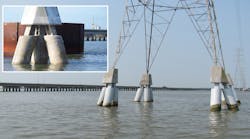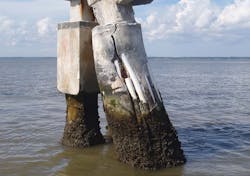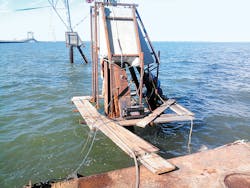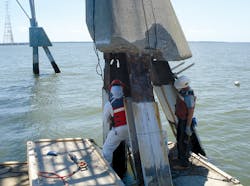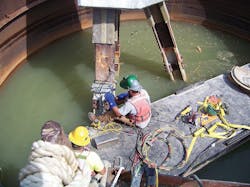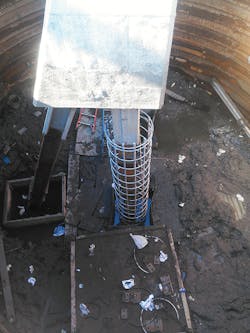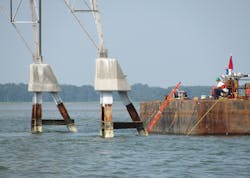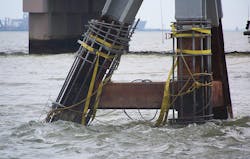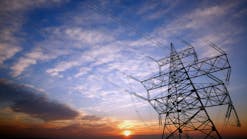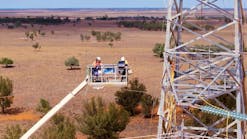A 2013 inspection revealed a series of transmission tower foundations crossing the James River in Virginia, U.S., needed to be upgraded. Dominion Energy knew it had to develop a solid project plan; it could not be just any project plan because the river crossing presented several significant challenges.
With the decommissioning of the Yorktown power station and other pending electric transmission projects, the double-circuit transmission line was important to meet the power demands of the Virginia Peninsula. The line also was located in one of the busiest shipping channels in Virginia. With approximately 700 barges and 200 ships traveling on the river per year, the project plan could not disrupt the shipping channel traffic and negatively impact the local economy. Dominion Energy also had to consider the 18 150-ft to 276-ft (46-m to 84-m) lattice transmission towers were located in water at various depths, the line had to remain energized while the upgrades were completed, and active avian nests were located on the towers and the nearby James River Bridge.
Project Scope
Dominion Energy launched its James River Crossing foundation upgrade project in May 2014. The utility has approximately 6600 miles (10,620 km) of transmission lines, many located in and around waterways. When the line was built in 1968, Dominion Energy used the best long-term alternative to corrosion prevention: marine-grade corrosion-resistant steel similar to ASTM A690.
In the early 1990s, the utility covered a portion of the H-piles with a fiberglass jacket-epoxy grout encapsulation system to further protect them against the harsh marine environment. A compound also was applied to the remaining section of the H-piles in the splash zone. However, this compound did not provide adequate protection. This resulted in the H-piles corroding at the compound-coated areas and the encapsulation system jacket ends, causing the epoxy grout to begin de-bonding from the H-piles.
The 2013 inspection showed a significant number of the H-piles in the splash zone had experienced partial to total plate-thickness loss. A structural upgrade of the H-piles was required to prevent foundation failure. The actual extent of the corrosion was not revealed until abrasive blast cleaning of the piles was performed. All foundations at the 18 tower locations were in far worse condition than the report indicated.
The project started out as an operations and maintenance repair project and transitioned to a capital upgrade project once it became evident that structural modifications were needed on all the tower foundations. The fender protection system for the two shipping channel crossing towers also had to be addressed. In most cases, the significant deterioration would have warranted a new double-circuit line. However, the towers were still in good shape, with new conductor-arm vang plates, insulators and hardware assemblies installed in the 2009-2010 time frame.
Completed in-house by Dominion Energy, extensive engineering work was required for this foundation upgrade project. The utility designed steel replacement sections to replace corroded portions of H-piles in the splash zone area. The H-pile steel replacement work included encapsulation and concrete cap repair. In addition, a reinforced concrete encapsulation was designed to extend from about 2 ft (0.6 m) below the cap all the way to 4 ft (1.2 m) below the mud line. The utility also redesigned the horizontal braces used on H-pile installations on five towers located in water ranging from 25 ft to 40 ft (7.6 m to 12.2 m) and replaced the fender protection system for the line where it crossed the designated shipping channel.
This upgrade project was the most economical and efficient solution. It alleviated the need to rebuild the line. Under favorable circumstances, it would have taken at least a year for Dominion Energy to obtain the applicable permits for a new line.
Nuts and Bolts
Once it was determined an H-pile had experienced an average thickness loss of 0.125 inches to 0.189 inches (3.2 mm to 4.8 mm), or an average thickness loss of 40% to 45%, the utility deemed it necessary to replace that portion of the H-pile section. The process included six steps:
1. Installing temporary bracing
2. Removing concrete from the cap bottom to perform portions of the required upgrading and welding work
3. Removing half of the H-pile section that did not satisfy minimum thickness requirements and installing its replacement section
4. Removing the other half of the H-pile section and installing its replacement section
5. Installing the permanent web splice plates
6. Installing the H-pile encapsulation system and repairing the concrete cap bottom.
The thickness of each of the corroded sections had to be measured to see how much of the H-pile length needed to be cut out. The different cutout lengths resulted in a customized structural upgrade for each H-pile. As a result, engineering work was ongoing throughout the project.
The reinforced concrete pier additions also were technically complex. They were designed to encapsulate and structurally transfer load from the upper upgraded H-pile sections to the existing H-pile sections without thickness loss located near the mud line zone.
To begin the installation, the existing H-piles were cleaned using a high-pressure water jet. The 1991 encapsulations around portions of the existing H-piles were allowed to remain in place. Steel shear clips were installed to ensure adequate transfer of load occurred from the pier addition to a good competent section of the H-pile. A hot-dip galvanized rebar cage then was installed around the existing H-piles.
Dominion Energy used components of an encapsulation system developed by Fox Industries/Simpson Strong-Tie but applied them in innovative ways. The encapsulation of the piles from the splash zone to several feet below the mud line consisted of a split-form 36-inch (0.9-m)-diameter ultraviolet-resistant fiberglass jacket with tongue-and-groove connections. The jacket was positioned around the rebar cage and connected with stainless-steel screws. A hose was positioned inside the jacket to tremie in a nonshrink underwater cementitious grout extended with aggregate. This grout mix has special properties and corrosion inhibitors to deal more effectively with marine-type environments.
In addition to the engineering work completed in-house for the H-pile section replacements and corrosion protection systems, Dominion Energy engineers also developed a new replacement horizontal brace system, located between H-piles of an individual foundation, that could be encapsulated fully following its installation. In the early 1990s, horizontal steel braces used on foundations at five tower locations in deep water were encapsulated with a reinforced-concrete grout mat that also covered the interior opening between the horizontal braces. This reinforced-concrete grout mat eventually cracked, de-bonded and fell off due to the fluctuation of the tide and movement of the foundation system. The original horizontal brace system, which used open H-pile beam members and connection plate attachments to the vertical and battered piles, was impractical to repair and encapsulate.
The new brace system used rectangular hollow structural sections instead of open shape sections. In addition, the new diagonal horizontal member of this brace system was offset toward the direction of the vertical H-pile. These changes and modifications aided in making possible the encapsulation of the brace system with an epoxy-fiberglass protection system. Although the offset of the new diagonal member places additional torque load in the battered piles, this is negated by the torsional resistance of the H-piles with the reinforced concrete pier additions.
Complex Installation
This work was extremely difficult. It required barges, cranes, divers and cofferdams. More than 85% of the reinforced concrete pier additions were done in wet conditions using divers without a cofferdam. Workers also had to contend with coastal conditions as well as winter weather. Dominion Energy also replaced a fender protection system constructed in 1968 of marine-grade corrosion-resistant steel H-piles. The fender system was not forgiving when impacted and difficult to repair when struck by a barge or ship.
Many repairs and modifications had been made to the fender system over the years because of excessive corrosion and collision damage. Dominion Energy worked with GAI Consultants Inc. to design a new fender system with two different impact zones, heavy and light. Composite material was used for the round piles and wales that consisted of high-strength directional fiberglass materials and a resin system. Manufactured by Composite Advantage, the FiberPILE material was selected because its structural properties absorb energy better than materials such as reinforced concrete and steel. This composite material also is not susceptible to corrosion.
Neighbors and Nests
The James River Crossing foundation upgrade project would not have been successful without extensive internal collaboration between Dominion Energy’s project management, communications, planning, engineering and construction management personnel. Frequent meetings were held to keep the project team abreast of developments and to address issues.
Dominion Energy also developed a communication plan that included public outreach to neighbors as well as local and county officials. The utility knew the project would garner attention from area residents and the media because it was located next to the James River Bridge (U.S. Route 17), so it proactively coordinated a boat ride for the media to learn more about the project.
In addition, Dominion Energy worked closely with several agencies, including the Army Corps of Engineers, Virginia Department of Game & Inland Fisheries, U.S. Department of Agriculture, U.S. Coast Guard, U.S. Fish & Wildlife Service, Virginia Marine Resources Commission, Virginia Institute of Marine Science, National Oceanic and Atmospheric Administration, and Virginia Department of Environmental Quality. These agencies periodically visited the work site and monitored it for compliance.
Active osprey and cormorant nests were located on some of the towers, and a peregrine falcon nest was located on the James River Bridge, adjacent to the line. Active nests with eggs or dependent young are protected under the Migratory Bird Treaty Act. Because the Dominion Energy work focused on the foundations and fender protection system, it was unnecessary to remove the nests from the towers. Dominion Energy took every precaution not to disrupt the nests by working on the unoccupied towers first. In addition, the utility worked with agencies to comply with the time-of-year restrictions for the androgynous fish migration, from Feb. 15 to June 30.
Multiphase Completion
Overall, the project was completed in several phases while the double-circuit line was energized without jeopardizing the compromised structural integrity of the foundations. The foundation upgrade work was completed in December 2015.
The project showed the importance of using quality materials and applications as well as coordinating with stakeholders. The project also required Dominion Energy engineers to exercise their creativity and devise long-term solutions that would ensure the reliability of the line for customers for the next 40 years. ♦
Bob Smith is a consulting engineer in Dominion Energy’s electric transmission organization. He holds a BS degree in civil engineering technology from the University of Pittsburgh at Johnstown and has been a licensed professional engineer in the Commonwealth of Virginia since 1987. He is responsible for performing and coordinating foundation designs as well as structural analysis for transmission line, substation and communications structures. With his 38 years of structural and foundation design experience in the utility industry, he provides mentoring and technical direction to other engineers within the utility’s electric transmission organization.
Julie Mills Taylor is a senior communications specialist in Dominion Energy’s electric transmission organization. She holds a bachelor’s degree in communications from the University of Tennessee and has worked as a communicator in the utility industry for 20 years. She joined Dominion Energy in 2015 and serves on the team responsible for strategic communications associated with the utility’s electric transmission projects and initiatives.
Editor’s note: This project was the Transmission Line Category 2017 Industry Excellence Award Winner at the Southeastern Electric Exchange.
